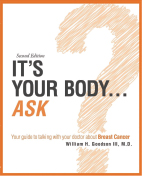Bookmark

Title: It’s Your Body…Ask: Your Guide to Talking With Your Doctor About Breast Cancer
Author: William H. Goodson III, MD
Publisher: Fort Alexander Press
Publication date: November 2016 (second edition)
Price: $12.95, paperback, 134 pages
If you Google the search term “breast cancer,” about 155,000,000 results will pop up in .83 seconds. Add to that pamphlets, journal articles, and library shelves bending under the weight of books written about breast cancer. That’s a mind-bending amount of information to parse through for the 231,000-plus American women diagnosed with breast cancer each year. But to make informed decisions about their care, these women need solid information that bridges the gap between excessive detail and oversimplification.
A recently published book, It’s Your Body…Ask: Your Guide to Talking With Your Doctor About Breast Cancer accomplishes that and more. The author, William H. Goodson III, MD, a recognized leader in breast cancer, is currently a physician and surgeon in San Francisco and a senior scientist at the California Pacific Medical Center Research Institute. This is the book’s second edition, and the author points out that when he wrote the first edition, the general plan of therapy for breast cancer could be summarized in several pages and some key questions. How far we’ve come!
The main part of the book is broken into three central questions to ask: (1) if you are healthy; (2) if you or your medical specialist thinks you might have breast cancer; and (3) if you’ve been told you do have breast cancer. By framing his book with general questions with multiple answers, Dr. Goodson uses a technique employed by polished public speakers to encourage participation and keep all participants, namely patient and doctor, focused and highly engaged.
Author’s Skills on Display
Many readers skip over a book’s introduction and cruise straight to chapter one. That would be a mistake here. Dr. Goodson nails the introduction with a pitch-perfect guide to helping a woman prepare for her initial doctor’s appointment. He explains that there are four main types of information—some very reliable and others less reliable. “When your physician makes a recommendation, ask what information she or he has used as the basis for the recommendation,” writes the author. The introduction also includes a concise, lay-friendly paragraph about understanding statistics, a subject few medical guidebooks tackle.
The answers to the questions explained in this book represent the collective histories of millions of women…. Participate in the creation of the recorded complex history of breast cancer so that other women can benefit from your experience. Speak for yourself.— William H. Goodson III, MD
Tweet this quote
Another strength of It’s Your Body is Dr. Goodson’s ability to hone complicated subject matter into digestible bites of information. His skill is displayed in the opening of chapter one, in which he breaks down the risk-to-reward ratios in screening, dealing with breast density, age, and family history. The ever-changing mammogram guidelines have created an air of uncertainty for women, a departure from the era when the clinical virtue of breast screening went unchallenged.
Dr. Goodson approaches this gray area with a sure hand, as is demonstrated in a terrific subchapter called, “Another Way to Think About Mammograms.” Using two cohorts of 10,000 women each—1 that had mammograms, and the other that did not—he gives the reader an easy-to-visualize picture of the rewards of mammography, along with a caveat. Then he adds: “You should discuss the risks versus the benefits with your physician. The decision, however, is yours.”
Simplifying Complex Medical Language
Perhaps the most difficult section of the book, in terms of grasping the difference between various breast cancers and their staging, is in part three. “There are five kinds of breast cancer. Many other words are used, and there are additional descriptions given to cancers within each type…. There are two types of in situ (a Latin medical phrase meaning in the place) and three type of invasive cancers; each has its own meaning and implications,” writes the author. Dr. Goodson then rolls up his sleeves and starts with lobular carcinoma in situ. He uses an excellent magnified view illustrating progression from normal ducts to invasive cancer.
More than any other section in the book, this one tests the author’s skills at simplifying complicated medical terms and procedures in language that most anxious women will be able to understand. This is no easy task when dealing with hormone receptors, growth factors, and HER2 overexpression. He passes the lay-friendly test with flying colors.
It’s Your Body is a small book with a value-added coda, further distilling medical jargon. It also includes a section on clinical trials that demystifies the process and, by virtue of Dr. Goodson’s well-calibrated enthusiasm, makes a solid case for participation. “The answers to the questions explained in this book represent the collective histories of millions of women…. Participate in the creation of the recorded complex history of breast cancer so that other women can benefit from your experience. Speak for yourself,” writes Dr. Goodson toward the end of his informative, economically written guide to breast cancer and self-advocacy, a much-needed spirit in the oncology community.
Although It’s Your Body is a guide for patients, there is much to learn between its covers for cancer care specialists, too. This book is highly recommended for The ASCO Post readership. ■

